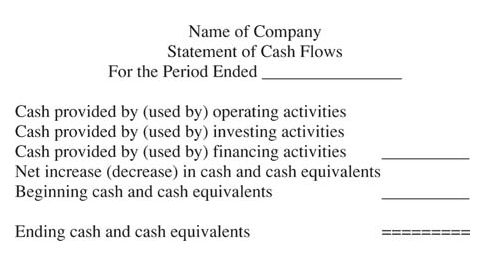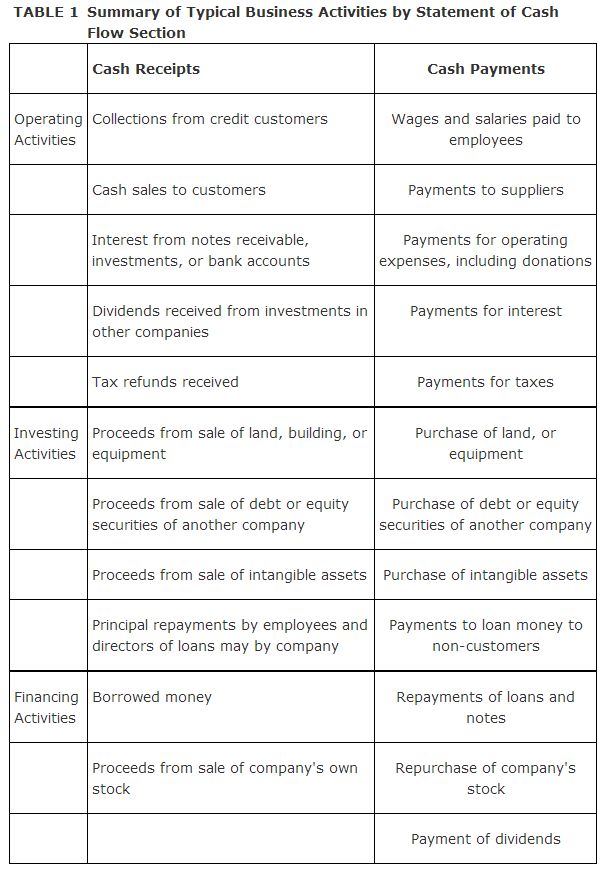Cash management is an important function for every business. Knowing what cash is expected to be received and what cash is required for payments is critical information in determining whether a company has excess cash for investment or will need additional cash to meet operating needs such as paying its employees or its suppliers.
The financial statement that reports activity in cash and cash equivalents for a period of time is called the statement of cash flows. Cash equivalents are highly liquid, short‐term investments that usually mature within three months of their purchase. U.S. Treasury bills, money market funds, and commercial paper are usually classified as cash equivalents. In this discussion when cash is used, it refers to cash and cash equivalents.
The statement of cash flows has four main sections: Three are used to classify the types of cash inflows and outflows during the period and the fourth reconciles the total cash balance from the beginning to the end of the period. A skeleton outline of the statement of cash flows would look like this:

![]()
As with all statements, the statement of cash flows has a three‐line heading stating the name of the company, the name of the statement, and the time period being reported on the statement (for example, month, quarter, year) with the period end date. The three sections of the statement are the operating, investing, and financing activities.
Operating activities
The first section is operating activities This section tells the reader whether or not the company generated cash from its day‐to‐day operations. These activities include cash collections from customers, payments to employees and suppliers, tax payments, the receipt of interest and dividends and interest paid. There are two acceptable methods of reporting operating activities. Each method is discussed under the topic “Preparing the Statement of Cash Flows.”
Investing activities
The second section is investing activities, which reflects how the company is using cash to grow/maintain its business. This section reports the activity in long‐term asset accounts, such as land, buildings, equipment, intangible assets, and investments (excluding those classified as cash equivalents). If a company has collections from long‐term notes receivable, they are reported as operating cash flows if the note receivable resulted from a sale to a customer, or investing cash flows if the note was taken for another purpose. Typical investing activities include the purchase and sale of equipment, purchase and sale of securities, and making and collecting loans.
Financing activities
In the third section, financing activities, the reader learns how the company chose to pay for its growth. Financing activities reports the activity in the long‐term liability and stockholders' equity accounts. Typical financing activities are receipt and payment of loans, issuance of stock, payment of dividends, and repurchase of the company's stock.
In reporting the changes in cash in the investing and financing activities sections, each type of cash inflow or outflow is shown separately in the statement. For example, if the company sold equipment for $7,000 cash and purchased equipment for $50,000, the statement would report these two activities separately. Similarly, if the company borrows $1,000,000 and repays $150,000 during the period, these activities are reported separately. See Table 1 for major classifications of cash flow by category
.

Cash reconciliation

The fourth section, the cash reconciliation, begins with the net change (increase or decrease) in cash that is the total of the operating, investing, and financing activities sections. The beginning of the period cash balance is added to the net change to obtain the ending cash balance. The ending cash balance is the same as cash on the balance sheet as of the end of the period.
Although the statement excludes non‐cash transactions, significant non‐cash transactions must be disclosed to the reader either below the statement or in the notes to the financial statements.
|
|
|
|
|
|
|
|
|
|
|
|
|
|
|
|
|
|
|
|
|
|
|
|
|
|
|
|
|
|
|
|
|
|
|
|
|
|
|
|